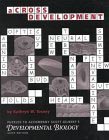





      |
|

Kathryn W. Tosney
The contents are composed of 2-3 crossword puzzles for each chapter of Scott Gilbert's Developmental Biology, 6th edition. Sample puzzles for 5th edition of Gilbert's Developmental Biology Preface: how to get the most from these puzzles How can you master both terms and concepts in developmental biology? The central problem is developing the ability to recall the information. You must learn to recognize terms and concepts in different guises, understand temporal-spatial relationships and processes, and assess experimental evidence. You must incorporate your knowledge so you can access it at will. How do you develop such recall? You can only read your textbook or your lecture notes so many times before diminishing returns make the exercise futile. To be able to recall, you must practice recall itself, testing your ability by quizzing your knowledge. You could use flashcards to quiz yourself, or you could work with your peers to quiz each other. An alternative method I've found to help my students uses crossword puzzles. Obviously, crosswords can help you with terminology. You need to recall terms to fill in the blanks. Simple. However, the crosswords in this book are also designed to help you learn and remember substantive information. Concepts and experiments are reiterated in the cues, often in a different guise than in your textbook to separate them from the lulling or even mind-numbing sequence of a text read for the nth time. Indeed, unlike most commercial crosswords, these puzzles offer half their utility simply through reading the cues. The cues are consequently longer than in most puzzles. Another consequence is that these puzzles can be useful even to the few people who loath crosswords. Those of you who scorn crosswords can still use these as a learning aid by simply treating the cues as fill-in-the-blanks quizzes. There is one trap that could greatly reduce the effectiveness of these puzzles, if you treat them like regular crosswords. We all know that the built-in reward for doing a crossword puzzle is successfully filling in all the blanks. Say you have filled in all the blanks on a puzzles just by going through the "across" cues. First, congratulations! Second, don't rest on these laurels. Check your results first by going through the "down" cues, and only then by referring to the answer key. If you don't, you miss half of the mental exercise. Because I have used some subterfuges to increase the amount of relevant information in each puzzle, the words you see in the key are not necessarily the key words from a chapter. Only occasionally are the words you enter vital terminology. For instance if you glance at the key for chapter 1, you do see "zygote", "contact", "transcriptional" and like words, invoking very pertinent developmental issues. But you also see "am", "tm" and "ru", which are hardly key terms. They result from my asking you to fill in only the missing letters for a word, rather than an entire word. This subterfuge increases the information-density of each puzzle, letting me quiz you by asking you to supply as few as two letters. In addition, sometimes the letters you enter are not for the vital terms in the cue; in these cases, the message is in the cue itself. Inevitably, there are also cues that are irrelevant to the topic. These are included merely so you can fill in more letters to help you decipher the relevant cues. A minority of such cues use puns, transpositions, anagrams, etc. to entertain those of you who truly love word games. These are not vital for solving the puzzles. These crossword puzzles also differ from others in another respect. I did not place the black squares in a symmetrical pattern because I felt that such anal retentiveness would be irrelevant to your needs. To use the puzzles, I suggest you read your assigned chapter and apply your own mode of studying first, to begin learning the information. Then use the puzzle for the chapter to test your recall. Recall tests are most helpful if you take them after you have put some information into your head to recall. You need not read earlier chapters to do a particular puzzle successfully. Because many instructors assign chapters out of sequence, each puzzle focuses on a particular chapter or portion thereof, with minimal reference to other chapters. In addition, the puzzles generally omit reference to the "sidelights and speculations" sections; they focus on the terms in bold face and the concepts and experiments within each chapter. Above all, enjoy the puzzles!
|
 Developmental Biology Published by Elsevier Science under Auspices of Society for Developmental Biology |
|||
|
Page Modified:
|
News | About SDB | Membership | Meetings | Jobs | Education Interactive Fly | Publications | Virtual Library |
© Society for Developmental Biology |